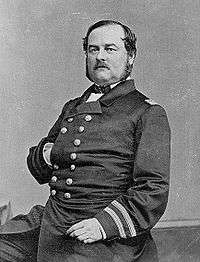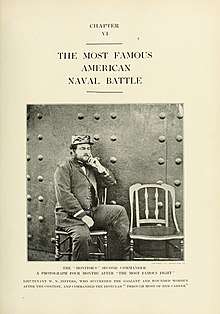William Nicholson Jeffers
Commodore William Nicholson Jeffers (October 6, 1824 – July 23, 1883) was a U.S. Navy officer of the 19th century. He took part in combat operations during the Mexican–American War and the American Civil War, and during the 1870s and early 1880s served as Chief of the Bureau of Ordnance.
William Nicholson Jeffers | |
|---|---|
 William Jeffers | |
| Born | October 6, 1824 Swedesboro, New Jersey |
| Died | July 23, 1883 (aged 58) Washington, D.C. |
| Place of burial | |
| Allegiance | Union |
| Service/ | |
| Years of service | 1840-1883 |
| Rank | |
| Commands held | USS Philadelphia (1861) USS Roanoke (1855) USS Underwriter (1852) USS Monitor (temporary) USS Swatara (1872) Chief of the Bureau of Ordnance |
| Battles/wars | Mexican–American War American Civil War |
Early life and career
Jeffers was born in Swedesboro, New Jersey, and was appointed midshipman September 23, 1840. His early service was in frigates Congress and United States, and during the Mexican–American War he took part in the attack on Alvarado, the capture of Tobasco, and the bombardment of Vera Cruz.[1]
In the 1850s he was engaged in numerous expeditions to Central America, and was responsible for a preliminary survey of the isthmus of Honduras.[1]
Civil War

During the early months of the Civil War, Jeffers commanded Philadelphia in the Potomac River and served in frigate Roanoke off Charleston and Hatteras Inlet. In December 1861 he took command of Underwriter and soon afterward took part in the capture of Roanoke Island and the destruction of the Confederate squadron at Elizabeth City. After the wounding of Captain John Lorimer Worden of USS Monitor during her historic engagement with CSS Virginia on March 9, 1862, Jeffers assumed command,[2] taking part mainly in shore bombardment in the James River.[1]
After Jeffers served aboard the Monitor, he was assigned as inspector of ordnance in Philadelphia and Washington, D.C., for the remainder of the war.[1][3]
Post-war career
Jeffers commanded Swatara in the Mediterranean and in African waters, and in 1873 was made chief of the Bureau of Ordnance. Commodore Jeffers served in this capacity for eight years and contributed much to the science and literature of naval ordnance. He died at Washington July 23, 1883, and was buried in the cemetery of the United States Naval Academy in Annapolis, Maryland.[1]
Namesake
The destroyer USS Jeffers (DD-621) was named in his honor.
References
- DANFS, Article: Jeffers
- Quarstein, 1997, p. 87
- Quarstein, 2010, p. 187
Bibliography
- Quarstein, John V. (1997). The Civil War On The Virginia Peninsula.
Arcadia Publishing. p. 128. ISBN 9780738544380. Book - —— (2010). The Monitor Boys: The Crew of the Union's First Ironclad.
The History Press. p. 349. ISBN 9781596294554., Book - DANFS, Dictionary of American Naval Fighting Ships. "William Nicholon Jeffers".
Department of the Navy; Naval Historical Center, Washington D. C. Retrieved July 20, 2013.
Further reading
- Bibliography of American Civil War naval history
External links and resources
- history.navy.mil: USS Jeffers
- "William Nicholson Jeffers". Find a Grave. Retrieved March 28, 2008.
- William N. Jeffers Rough Notes & Memoranda: Ordnance, 1841-1872, MS 167 held by Special Collections & Archives, Nimitz Library at the United States Naval Academy
Notes
- This article incorporates text from the public domain Dictionary of American Naval Fighting Ships.